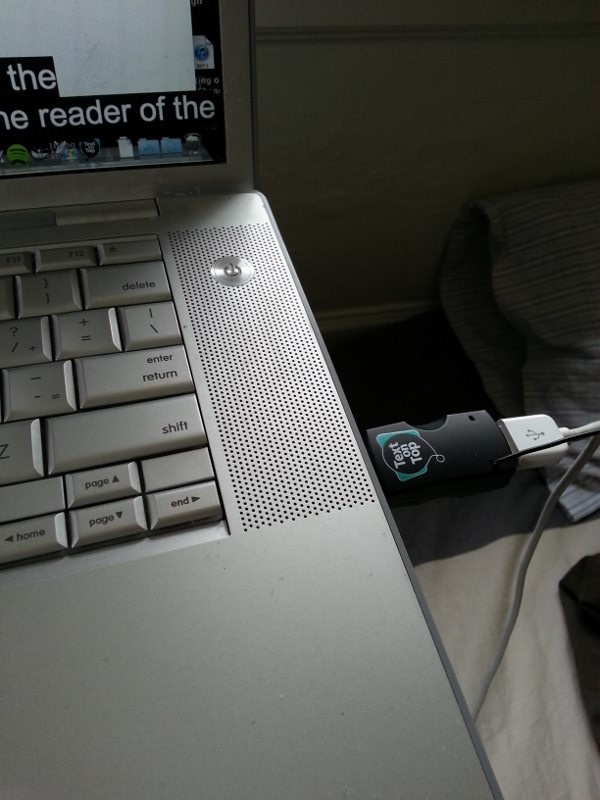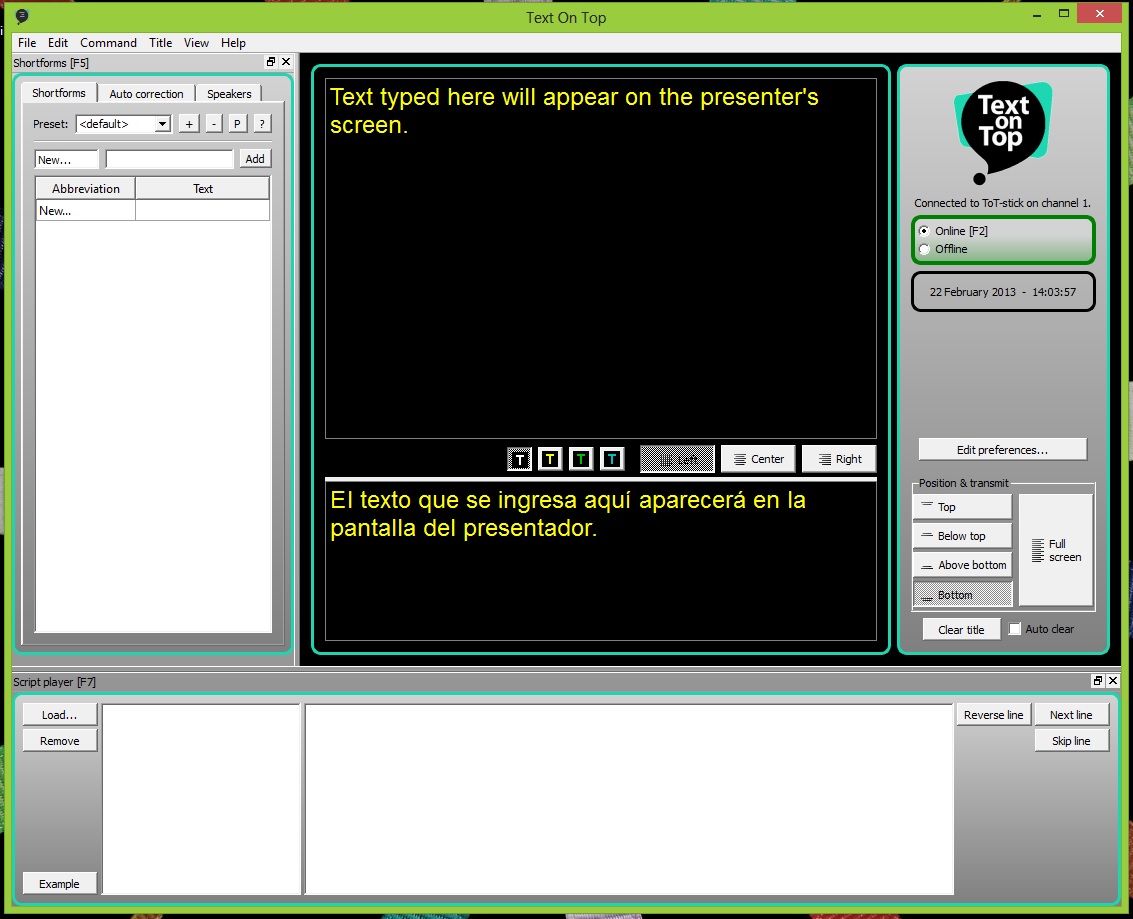What is Text-On-Top?
Text-On-Top is a solution for live-captioning presentations, lectures, conferences, and other events where the speaker may use visual media. It is manufactured by the Dutch company Velotype that also produces the Velotype keyboard, a syllabic-orthographic method of text entry. It is used to caption live broadcasts in the Netherlands.
Often in presentation situations, it is cumbersome for individuals who use CART to constantly have to look back and forth between two different screens – one containing the speaker’s PowerPoint presentation, for example, and the one that displays the realtime captioning. Text-On-Top solves this problem by overlaying realtime captioning on the presenter’s visual media so that the text appears at the bottom of the same screen just like closed captioning would on your TV so you don’t need to lug in your own projector or worry about having another display device available.
What’s included in the system?
Text-On-Top includes two USB devices that resemble the form and function of USB flash drives. You plug one into the captioner’s computer and the other into the presenter’s computer and the communicate automatically and wirelessly. Each device consists of 2 GB of internal memory which holds the connection software and the antenna through which the connection is made. As a result, you won’t have to worry about loading the software in advance on the presenter’s laptop as it is built in. A cool thing is each device has a USB port on the other end so that using the device doesn’t deprive you of a precious USB port.
When you plug it in, your computer will recognize it just like a regular ol’ USB disk and so finding and launching the software is pretty straightforward and “plug-and-play” in all respects. It works with both Windows and Mac.


Operation
After you open the software on both computers, the rest is pretty much automatic. If you don’t see text coming out on the presenter’s end, make sure your devices are both operating on the same channel. But other than optional settings like text color, position, and size I really had to do nothing else to get them working.

It’s not absolutely necessary that you be a stenographer in order to use Text-On-Top. You can just write the text as you normally would on a regular keyboard if you can type fast enough or if the captions don’t need to be 100% verbatim. The software also lets you define keyboard shortcuts for common words and phrases that will expand out to their full forms before being sent out as captions.

If you are a stenocaptioner, set your CAT software to output the text to any program and make sure the Text-On-Top program is the active window when you are writing.

How much is it?
A set of two devices costs €199.00 which for me amounted to $299.00 plus $40.00 for shipping.
Conclusion
I haven’t had a chance to use it on a job yet but as far as I can tell, it looks like a great extra you can offer your clients for group CART situations. I will update you guys as I gain more experience.
¿Qué es Text-On-Top?
Text-On-Top es una solución que te permite mostrar subtítulos durante presentaciones, discursos, u otros escenarios en una manera parecida a Closed Captioning. Está fabricado por la empresa holandesa Velotype que también produce el Velotype, un teclado silábico que se utiliza en los Países Bajos para realizar Closed Captioning en vivo.
La ventaja que te ofrece es el poder mostrar los subtítulos en la misma pantalla que una presentación PowerPoint. En situaciones con múltiples participantes que necesitan CART (transcripción simultánea) ya no hay que traer otro proyector u otro dispositivo de pantalla para el capcionista. Además, los usuarios del servicio ya no tienen que ver saltando entre los subtítulos y la pantalla que contiene los medios visuales del orador. Toda la información audiovisual aparece en una sola ubicación para que todos la accedan fácilmente.
¿En qué consiste el sistema?
El sistema Text-On-Top consiste en dos dispositivos parecidos a memorias USB y se utilizan en casi la misma manera. Se enchufa uno a una puerta USB de la computadora del estenotipista y el otro a la computadora del presentador. Se comunican a través de una conexión inalámbrica. Cada dispositivo está compuesto de la antena transmisora y también 2 GB de memoria interna en la cual reside el software requerido así que no tendrás que cargar el software de antemano en ninguna de las dos computadoras. Al enchufarlo, la computadora lo reconoce como una memoria USB para que accedas el software — es verdaderamente “plug-and-play” y compatible con Windows y Mac.


La Operación
Después de abrir el programa en ambas computadoras, el resto se ocurre automáticamente. Si no te sale el texto en la computadora del presentador, aseguráte de que los dos dispositivos están transmitiendo en el mismo canal. Menos los ajustes opcionales como el tamaño, el color y la posición del texto, no hay que hacer nada más.

No es necesario que escribas los subtítulos mediante la estenotipia. Podés ingresar el texto como normal vía un teclado convencional si podés teclear tan rápido para seguir el ritmo del orador o si los subtítulos no necesitan ser textuales. Hay incluso una función que lo hace posible definir atajos del teclado para los términos y frases más frecuentes en un discurso.
Si realizás los subtítulos mediante la estenotipia, tendrás que configurar tu software CAT para que de salida al texto a otros programas y Text-On-Top debe ser la ventana activa.
¿Cuánto cuesta?
Un par de dispositivos cuesta €199,00. Yo los compré por $299,00 + $40,00 por el envío.
Conclusión
Aunque todavía no he utilizado Text-On-Top en una tarea, por lo que me doy cuenta creo que es una buena prestación adicional que podés ofrecer a tus clientes en las situaciones susodichas. Les doy actualizaciónes en cuanto obtenga más experiencia.

This is a great review. From your photos, it looks like the text is just placed at the bottom of the screen, blocking out whatever is underneath it. Is that block of text positionable? Can you change the size and shape of it to make it have fewer lines or be less wide or anything? Can you move it to the top of the screen? My main concern with this device, great as it looks, is that presenters will be like, “Hey, that’s covering up the bottom of my PowerPoint! There’s vital information on there that nobody can read now!” It might be possible to show their PowerPoint in a less-than-maximized window, but that could screw up the aspect ratio, making their pictures look weird, plus the screen of the un-maximized window looks a little sloppy. If it were possible to manipulate the size, shape, and position of the Text-on-Top text, though, you could scan through their slides before the talk and make sure that none of their important information was obscured by the captions.
Yeah, you can place the text on top, middle, or bottom of the screen, change the font size, color, and the background (or not have one). You can also make it right, left, or center aligned. And you can control the amount of lines.
I’m still working on getting Eclipse to not preformat text before sending it through the keyboard macro so that it doesn’t make weird line breaks and stuff.
Why does it keep wanting to make the keyboard macro text be formatted like the document?? Like putting the damn line breaks in where they occur in the transcript? I just want the pure text, nothing else. Is that really too much to ask for?!
You can fix that by going to realtime -> output format -> keyboard macro and checking “force margins”, then setting right margin to 99999.
Ah thanks! I’ll let you know how it goes.
-S
So do you use the CC macros in Eclipse to re-position the text while the presentation is going on depending on where the presenter’s text is on the screen?
I don’t do CC yet so have not learned those commands 🙂